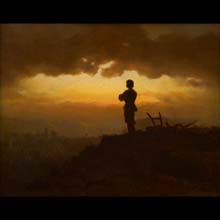
material: oil on canvas
dimensions: 45 x 55 cm
description: Grottger very often took advantage of the poetic and painterly qualities of the nocturne in his works. Permeated by religious and patriotic mood, Evening Prayer of a Farmer was inspired by the work of his Viennese teacher, Christian Ruben, and the paintings by an outstanding German Romantic artist, Caspar David Friedrich. The work depicts a peasant standing on the edge of the hill who, hearing the bell of the distant church, has stopped ploughing to recite the evening Angelus prayer. Depicted with his back to the viewer, the peasant is staring at the vast mountainous landscape, with a huge sweep of the overcast sky above it. A dark, narrow palette is based on browns, blacks, rust reds and yellows. The figure of the man contemplating the mystical beauty of nature and uniting with the Creator is silhouetted as a dark shape against the sky, illuminated with a glow of the setting sun in the middle. The farmer portrayed in this way constitutes an integral element of the surrounding nature. The Romantic motif of a person contemplating the beauty of nature, with their back to the viewer, reflects the pantheistic approach, typical of the era. The deep experience of nature is accompanied by the patriotic significance of the painting. For Poles deprived of their statehood, patriotism was a kind of national religion, and the representatives all of social classes were expected to practise it. The religious, hard-working, serious and dignified man, portrayed by Grottger in this work, symbolizes the model of the Polish countryside people. This social class, treated with contempt for centuries, more and more aware of its rights and duties in the 19th century, gained fundamental civil rights gradually. Introduced to literature and art by the Romantics, the peasantry fascinated with their familiarity, vividness, strength and fitness, gaining a high position in the hierarchy of national myths. Aleksandra Krypczyk
exposition: The Gallery of 19th Century Polish Art in Sukiennice,
The Cloth Hall, 1, Main Market Square
key: Romanticism. Towards national art >>>
dimensions: 45 x 55 cm
description: Grottger very often took advantage of the poetic and painterly qualities of the nocturne in his works. Permeated by religious and patriotic mood, Evening Prayer of a Farmer was inspired by the work of his Viennese teacher, Christian Ruben, and the paintings by an outstanding German Romantic artist, Caspar David Friedrich. The work depicts a peasant standing on the edge of the hill who, hearing the bell of the distant church, has stopped ploughing to recite the evening Angelus prayer. Depicted with his back to the viewer, the peasant is staring at the vast mountainous landscape, with a huge sweep of the overcast sky above it. A dark, narrow palette is based on browns, blacks, rust reds and yellows. The figure of the man contemplating the mystical beauty of nature and uniting with the Creator is silhouetted as a dark shape against the sky, illuminated with a glow of the setting sun in the middle. The farmer portrayed in this way constitutes an integral element of the surrounding nature. The Romantic motif of a person contemplating the beauty of nature, with their back to the viewer, reflects the pantheistic approach, typical of the era. The deep experience of nature is accompanied by the patriotic significance of the painting. For Poles deprived of their statehood, patriotism was a kind of national religion, and the representatives all of social classes were expected to practise it. The religious, hard-working, serious and dignified man, portrayed by Grottger in this work, symbolizes the model of the Polish countryside people. This social class, treated with contempt for centuries, more and more aware of its rights and duties in the 19th century, gained fundamental civil rights gradually. Introduced to literature and art by the Romantics, the peasantry fascinated with their familiarity, vividness, strength and fitness, gaining a high position in the hierarchy of national myths. Aleksandra Krypczyk
exposition: The Gallery of 19th Century Polish Art in Sukiennice,
The Cloth Hall, 1, Main Market Square
key: Romanticism. Towards national art >>>












